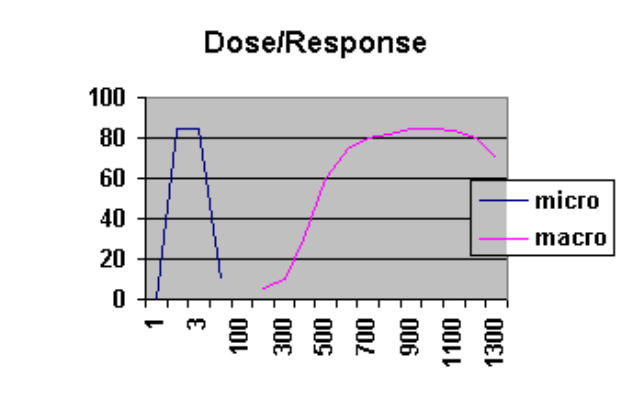
Mineral Nutrition for Slipper Orchid Growers
AnTec Laboratory - Bob & Lynn Wellenstein
Everyone's conditions are very different, and you must balance the various factors of your growing with each other. What is stated
here are the factors we take in to consideration regarding mineral nutrition: it is hoped that there may be aspects discussed that may be
useful to you. We suggest that careful experimentation on small numbers of plants be carried out before anyone makes any major
change in their growing conditions. Also, everyone does not have the same goals in growing, and may not be interested in trying to
tease every last bit of potential out of their plants. As a result, we’ll also discuss some options to consider if you want to grow these
plants without going into the details of matching your fertilizer with a water quality analysis.
Let’s discuss mineral nutrition first in a general sense, without the detailed facts and figures, then we’ll go over the details for those
who are interested. You need to have some idea of your water quality with regard to the type and levels of dissolved minerals (see
Water Quality for Slipper Orchid Growers). If you do not have this information, but you suspect that your water is quite hard, there are
some steps you might take until you obtain an analysis. You should use fertilizer sparingly, fertilizing only every second or third
watering and utilize fertilizers with highly available nitrogen sources and little or no urea, so that the smaller amounts of fertilizer you
can use will be utilized efficiently. You should also flush the pots extensively with your irrigation mix with every watering. Not
allowing the media to dry completely will aid in salt elimination, but can also lead to rotted roots, so using a more open mix than you
normally would and watering more frequently may also be of help, letting you water without the mix completely drying out but still
keeping some air supply at the roots. If you are seeing what appears to be symptoms of a mineral deficiency, or dehydration of the
plants, remember that to check the most obvious and most common cause first, loss of roots due to rots.
Dose response generalization
If you have a water analysis in hand, you can then match
your fertilizer better to your needs. If you have 30 – 50 ppm
or more calcium available in the water, then you should
choose a balanced fertilizer without calcium. If you have 20
– 30 ppm magnesium or more in your water then you can
also utilize a fertilizer that does not provide magnesium. If
you do not have sufficient levels of one or the other, you can
either use a fertilizer containing them, or do a supplemental
feeding every 2 – 3 weeks with calcium nitrate for the
calcium and/or Epsom salts for the magnesium needs of your
plants. Otherwise, use a balanced fertilizer for the rest of the
macronutrients sparingly (try to keep TDS of irrigation mix
[water plus fertilizer] at 350 ppm or lower, and the chances
that you will encounter nutrient deficiencies is small. The
only further caution is to check the pH of your water
fertilizer mix and make sure that it is in range for the types
of plants you are growing (see Use of Calcium Based
Supplements for Paphs for more details). However, if your
goal is to grow the plants as well as possible, we’ll try to
provide you with some tools here to fine tune your program,
and diagnose any problems that may arise.
There is a definite dose/response curve in plant mineral nutrition, where increasing levels, as long as other factors are in balance, result
in increased growth rates. At a certain point the gains start to become less rapid, and then no further gain is observed. Optimal feeding
is at a level in the area where the gains start to level off. If levels are increased above this level eventually you hit a point where plant
growth is reduced, in the case of slipper orchids it is usually due to salt level build up at the roots. The graph below is a simple
representation of these growth curves for micro and macronutrients, the numbers are arbitrary and meaningless except in a relative
sense. Please note that the response curve for many micronutrients is very steep, being absolutely essential in very small quantities, but
many, such as boron, are also very toxic in quantities that are only slightly higher. I have heard hydroponic growers cite a rule of
thumb for micronutrients that "twice optimal is toxic." The obvious corollary is use extreme care if you are supplementing the micro
or trace elements. Another caution is that many plant hormones that are commonly used as supplements have similar dose response
curves as the microelements, so again use care to follow label instructions, more is not better, at best you are wasting your money at at
worst you may be damaging your plants. While the dose response curve for macronutrients is somewhat more forgiving, we still want
to stay fairly close to the optimal area in choosing our fertilizer levels.
You need to consider mineral nutrition of your plants as a combination of your water and the fertilizer you add. What we currently feel
is a reasonable range of nutrients for a steady feed program (combined level provided by both the water and the fertilizer) for Paphs is
provided in the following chart, but please remember that the absolute values that you should use will be affected by light levels, day
length, temperature, potting mix, air flow, size of plants and irrigation frequency.
Mineral Nutrition for Slipper Orchid Growers
file:///C|/webpage/minnut2.html (1 of 5) [9/19/2000 7:11:13 AM]

Element Minimum ppm Maximum ppm
Nitrogen (NO
3
& NH
4
) 60 100
Potassium 60 100
Calcium 30 50
Magnesium 15 30
Phosphorus 30 50
Sulfur 15 25
Boron trace < 0.8
Iron > 0.5 2
Manganese > 0.2 2
Zinc 1 2
Copper trace < 0.2
Molybdenum trace < 0.05
At a very practical level, if you are using a balanced low urea commercial fertilizer at a reasonable rate (say 50 –100 ppm nitrogen),
your likely only serious mineral nutrition concerns are calcium and magnesium levels (which are related to also to your water
analysis), and the pH of your irrigation mix. If you are using a pure water source then to a certain extent your resolution of the calcium
and magnesium levels is somewhat easier, you simply have to supply them at the level you want. Several commercial fertilizers are
available that provide one or both of them, but many have neither. Your choices are to select one of the fertilizers that contain
sufficient levels, or to feed calcium nitrate once every 2-3 weeks and Epsom Salts (magnesium sulfate) at another feeding every 2 – 3
weeks. Even some of the fertilizers that have these two elements in them contain them at sub optimal levels for use in pure water, so a
periodic feed of calcium nitrate and Epsom Salts may still be indicated even with them. If you are working with water with higher
concentrations of these elements you may need to choose a fertilizer that does not contain them to maintain as much balance as
possible in your program. As discussed earlier, if you have extremely high water salinity, you may have to fertilize at well below the
sub optimal levels to avoid salt build up problems for your plants roots.
Water/ fertilizer pH is another commonly overlooked area, and an area where I think many folks could drastically improve their plants
health. Various elements are available at different levels depending on the pH of the solution they are dissolved in, with some
becoming virtually unavailable if the pH goes too far out of range. We use a base line pH in the 6.6 range for our irrigation mix, and
use calcium supplements on the mix of strongly calcicolous plants and those associated with ultrabasic rock. This is explained in more
detail in Use of Calcium Based Supplements for Paphs. Be aware that most municipal water supplies have artificially raised pH’s to
reduce leaching of toxic substances into the water. Also, purified water is extremely susceptible to wide pH swings when fertilizer is
added, having little buffering capacity (our RO with Peter’s Cal-Mag at 100 ppm N drops to about pH 4.3, with Jerry’s Grow Foliage
formula at 1 teaspoon per gallon it gives us pH 6.4). Rain water has both the lack of buffering and the possibility of very acid pH to
start with. Fertilizers differ in their alkalinity or acidity depending on composition. You may be able to match a fertilizer to your
condition to arrive at an acceptable pH, for example an acidic fertilizer used with pH 8.0 municipal water may end up at a range in the
high 6’s. It is important to know the pH of your final irrigation mix, and make adjustments if necessary to get it into an appropriate
range. We use potassium hydroxide to raise our pH, phosphoric acid is commonly used to lower pH. Vinegar is commonly mentioned
as useful for lowering pH, however we do not have experience with it. It is also possible to use a limited amount of potassium silicate
to raise your pH, follow label directions to avoid using too high a level. Do not try to raise the pH levels of fertilizer concentrates that
contain calcium or magnesium and phosphorus, you may cause precipitates to form. The pH adjustment of these fertilizers must be
made in the diluted form.
The charts below summarize additional information regarding mineral nutrition. The relative numbers of atoms in plant tissue is a
generalized approximation based on molybdenum being 1, to give a rough’ idea of the relative needs of the plants for each of these
Mineral Nutrition for Slipper Orchid Growers
file:///C|/webpage/minnut2.html (2 of 5) [9/19/2000 7:11:13 AM]

elements, note that it is based on a number of atoms basis, not weight basis. It illustrates the large differences in the plant’s needs for
macro versus micronutrients, and also helps illustrate the higher needs for calcium and magnesium, which are often overlooked, and
are present in reasonable quantities in only about 1/3 of the commercial fertilizers I’ve surveyed.
The elements tranlocatability in the plant is also important in disgnosing deficiencies. If the element is translocatable, that is the plant
can remove it from tissue in one area and transport it for use in another, then symptoms of deficiency typically appear in the older
tissue as the plant mobilizes the element from the more expendable older tissue to the newer growing areas. Conversely, if it is not
translocatable, then the deficiency will show more in the new growing areas of the plant. Another diagnostic indicator to pay attention
to is the location of the symptoms, are they marginal, interveinal or generalized on the leaf? Again, I’d like to point out that the most
likely cause of a mineral deficiency (unless you are not fertilizing at all) is the loss of the roots of the plant, leaving it unable to take up
the needed nutrient levels.
Element Symbol Form
Available to
Plants
Trans
locatable
Deficiency
Induced by
Excess of
(Antagonism)
Most
readily
available
pH
Unavail-
able pH
range
Relative No.
Atoms in
Plant Tissue
Hydrogen H H
2
O
60,000,000
Carbon C CO
2
35,000,000
Oxygen O O
2
, H
2
O
30,000,000
Nitrogen N
NO
3
-
, NH
4
+
yes Potassium
Phosphorus
6.0 – 8.0 <4.5, >9.5 1,000,000
Potassium K
K
+
yes Nitrogen Sodium 6.0 – 10.0 <4.5 250,000
Calcium Ca
Ca
++
slightly Potassium
Sodium
Magnesium
6.5 – 9.0 <4.5, >10.5 125,000
Magnesium Mg
Mg
++
yes Potassium
Sodium
Calcium
Zinc
6.5 – 9.0 <4.5, >10.5 80,000
Phosphorus P
H
2
PO
4
-
,
HPO
4
--
yes
6.5 – 7.8 <4.8 60,000
Sulfur S
SO
4
--
no
5.8 – 10.0 <4.5 30,000
Boron B
BO
3
---
, BO
7
--
no Calcium 5.0 – 7.5 <4.0, >8.0 2,000
Mineral Nutrition for Slipper Orchid Growers
file:///C|/webpage/minnut2.html (3 of 5) [9/19/2000 7:11:13 AM]

Iron Fe
Fe
+++
, Fe
++
no Potassium
Phosphorus
Zinc
Copper
4.0 – 7.5 >10.5 2,000
Manganese Mn
Mn
++
no Potassium 5.0 – 7.5 >9.5 1,000
Zinc Zn
Zn
++
no Potassium
Phosphorus
5.0 – 7.5 <4.0 300
Copper Cu
Cu
++
, Cu
+
no Potassium 5.0 – 7.5 <4.0 100
Molybdenum Mo
MoO
4
--
slightly
6.2 – 10.0 <4.5 1
Signs of Deficiency or Excess of Mineral Elements
Element Primary Functions in Plant Signs of Deficiency Signs of Excess
Nitrogen Growth of green (leaf and
stem)portions of plant.
Reduced growth, vigor. Chlorosis
of older leaves first, premature
leaf drop
Soft growth, spindly growth,
leaf curl, reduced flowering,
symptoms of Potassium
deficiency
Potassium Root growth, sugar and starch
production, cell membrane
integrity
Dwarfing, chlorosis of older
leaves first, leaf curling
Deficiency symptoms of
nitrogen, magnesium, calcium,
iron, zinc, copper, manganese.
Calcium Cell wall formation, cell
division, enzyme catalyst,
neutralization of toxic
metabolites
Poor growth, deformed newer
leaves, chlorosis of newer leaves,
blackened areas at leaf ends and
new growths with a leading
yellow edge, stunted, shortened
roots, dead root tips.
Symptoms of magnesium
deficiency
Magnesium Chlorophyll and protein
production, carbohydrate
metabolism, enzyme activation
Interveinal and marginal chlorosis
starting in the older leaves,
increase in appearance of
anthocyanin in leaves, necrotic
spotting
Symptoms of calcium
deficiency
Phosphorus Constituent of nucleic acids,
coenzymes NAD and NADP
required for photosynthesis,
respiration and many metabolic
processes, and the energy
compound ATP. Essential for
root growth, flowering and seed
production
Older leaves are affected first, an
increase in anthocyanin pigment
and a dark blue green coloration,
sometimes with necrotic areas,
and stunting.
Symptoms of nitrogen, zinc,
iron deficiencies.
Mineral Nutrition for Slipper Orchid Growers
file:///C|/webpage/minnut2.html (4 of 5) [9/19/2000 7:11:13 AM]

Sulfur Protein formation,
photosynthesis, and nitrogen
metabolism
Root stunting, general chlorosis
starting with younger leaves
Boron Sugar transport, DNA synthesis Death of meristematic tissue, root
stunting, no flower formation
Interveinal leaf necrosis
Iron Component of cytochromes and
ferrodoxin, synthesis of
chlorphyll
Interveinal chlorosis of newer
leaves
Manganese Enzyme activation in respiration
and nitrogen metabolism
Interveinal chlorotic and necrotic
spotting
Stunting, necrotic spotting of
leaves
Zinc Trytophan synthesis, enzyme
activation
Smaller, distorted leaves,
stunting, interveinal chlorosis of
older leaves, white necrotic
spotting, rosetting
Symptoms of magnesium or
iron deficiency
Copper Enzyme component, electron
carrier protein in chloroplast
Stunted, misshapen growth. Symptoms of magnesium or
iron deficiency
Molybdenum Nitrogen and potassium
metabolism
Chlorotic interveinal mottling,
marginal necrosis, folding of the
leaf, no flower formation
Nitrogen Source Residual pH Effect
Urea acid
Ammonium nitrate acid
Ammonium chloride neutral
Ammonium sulfate acid
Diammonium phosphate acid
Calcium nitrate basic
Potassium nitrate basic
Dried blood acid
Dried fish meal acid
Raw bone meal acid
AnTec Laboratory
P.O. Box 65
Candor, NY 13743 USA
607 659-3330 http://ladyslipper.com
Images and text copyright 2000 AnTec Laboratory May be reproduced by nonprofit societies if presented in its
entirety.
Mineral Nutrition for Slipper Orchid Growers
file:///C|/webpage/minnut2.html (5 of 5) [9/19/2000 7:11:13 AM]
